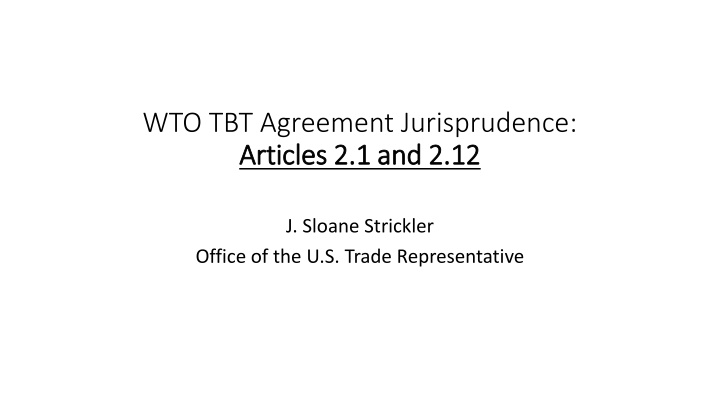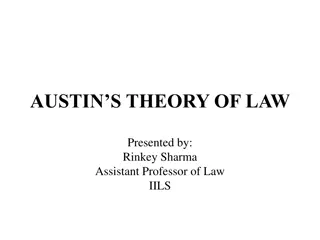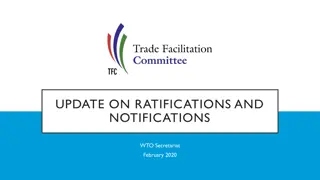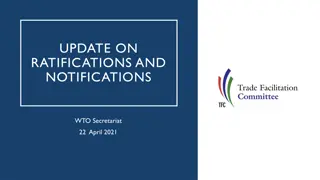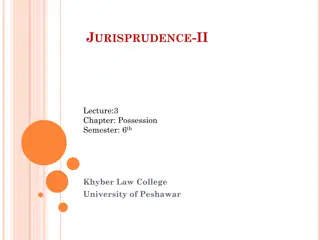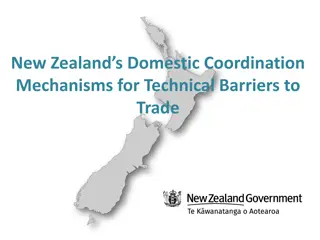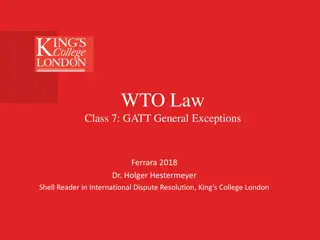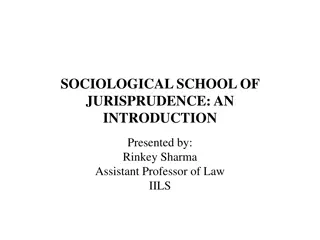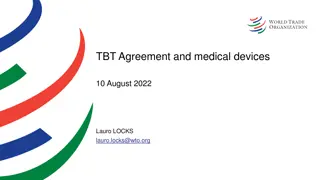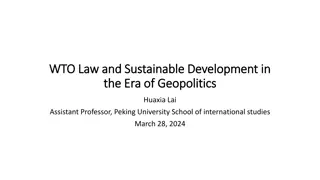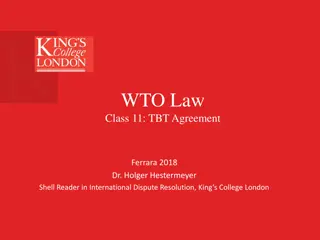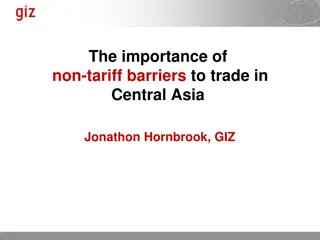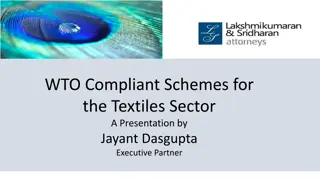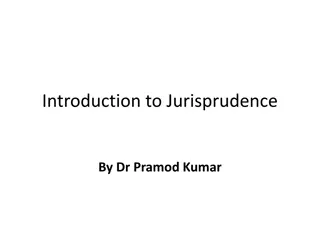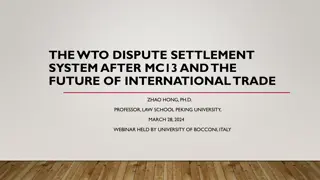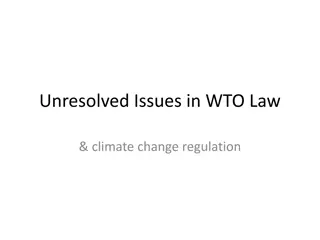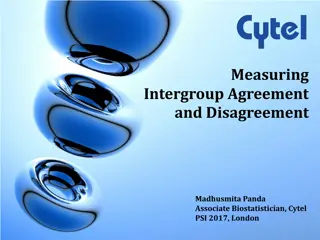WTO TBT Agreement Jurisprudence: Understanding Article 2.1 and 2.12
The WTO TBT Agreement's Articles 2.1 and 2.12 focus on ensuring non-discriminatory treatment for imported products compared to domestic and other countries' products. Article 2.1 emphasizes the concept of "like products" and examines competitive relationships between them to determine if they receive equivalent treatment. The criteria for determining likeness involve product nature, market competitiveness, and end-use. The perspective of regulatory authorities and consumers in assessing product similarity is also debated within the context of technical regulations.
Download Presentation

Please find below an Image/Link to download the presentation.
The content on the website is provided AS IS for your information and personal use only. It may not be sold, licensed, or shared on other websites without obtaining consent from the author.If you encounter any issues during the download, it is possible that the publisher has removed the file from their server.
You are allowed to download the files provided on this website for personal or commercial use, subject to the condition that they are used lawfully. All files are the property of their respective owners.
The content on the website is provided AS IS for your information and personal use only. It may not be sold, licensed, or shared on other websites without obtaining consent from the author.
E N D
Presentation Transcript
WTO TBT Agreement Jurisprudence: Articles 2.1 and 2.12 Articles 2.1 and 2.12 J. Sloane Strickler Office of the U.S. Trade Representative
Article 2.1: Overview Members shall ensure that in respect of technical regulations, products imported from the territory of any Member shall be accorded treatment no less favourable than that accorded to like products of national origin and to like products originating in any other country. Scope: Article 2.1 prohibits both discrimination of an imported product compared to a domestic product (National Treatment (NT)) and discrimination between imported products from different Members (Most Favored Nation (MFN)). Standard: Two key concepts like product and treatment no less favorable
Article 2.1: Like Product Article 2.1 does not apply to the treatment of all products. Rather, the discrimination disciplines of Article 2.1 only arise when discussing the treatment afforded like products. What products are like ? The WTO has interpreted like products as those product that are in a competitive relationship with one another. Thus a more stringent regulatory burden for autos than avocados will not raise WTO concerns.
Article 2.1: Like Product What products are in a competitive relationship with one another? Sometimes it is very clear. Obviously, canned tuna produced from different countries compete against one another in the same market and would be considered like products. Sometimes it is less clear. What must be examined generally is the nature and extent of the competitive relationship between the relevant products. No one approach will necessarily be appropriate for each analysis.
Article 2.1: Like Product In examining likeness, the end market use will obviously be relevant, but even if the products are substitutable, that does not mean necessarily that they should be considered like products. One famous example is of a dispute regarding construction materials where the imported product contained a dangerous input, asbestos, and the domestic product did not. The products were used for the same purpose, but the WTO decided that this difference in the products was enough to say that they were not like products with one another.
Article 2.1: Like Product One key point that is still being discussed is from what perspective must the regulating authority think of different products? The traditional viewpoint has always been that the perspective is of the consumer. But if toxicity is a relevant data point, as it was in the construction materials dispute I just referred to, it is not clear how a consumer would necessarily know the difference without a regulatory context.
Article 2.1: Like Product It may be that adopting a strict consumer point of view is not always appropriate, and that it may be preferable to take account of the regulator s perspective in certain cases. For instance, what about plastic bags versus paper bags? From the perspective of the consumer, they may both be bags, but from the regulator s perspective regarding environmental protection, they may be very different products.
Article 2.1: No Less Favorable Treatment Once the group of like products is determined, the next question is whether the measure provides less favorable treatment to some subset of that group of like products. The WTO Appellate Body has interpreted that the phrase no less favourable treatment to indicate a two step analytical approach. First, the question is whether the measure results in a detrimental impact on the condition of competition for the complainant s product compared to the like product in the importing Member or like product of other Members. If the answer to the first question is yes, then you ask a second question. Whether that detrimental impact stems from a legitimate regulatory distinction in the sense that the measure is even-handed. This two step analysis closely adheres to discrimination obligations in other WTO agreements (e.g., GATT 1994 and GATS).
Article 2.1: No Less Favorable Treatment What is a detrimental impact on the conditions of competition? This question could be asked and answered any number of ways. For example: Has the measure resulted in higher costs for the complainant s product versus the comparable like product? Has the measure reduced the profit margin for selling the complainant s product more so than the comparable like product? Has the measure otherwise limited the market access of the complainant s product more so than the comparable like product? Does the measure dis-incentivize the purchase of complainant s product in the home market more so than other comparable like products? Does the measure limit the ability of the complainant s product to be sold at retail in the importing Member s market? Essentially the question is whether the measure is resulting in an asymmetrical impact among like products.
Article 2.1: No Less Favorable Treatment In what way can a measure cause a detrimental impact on complainant s product? The measure can, of course, draw distinctions based on origin, setting out different, and, possibly, more burdensome regulatory requirements for foreign products than domestic ones, for example. We refer to a detrimental impact caused by such distinctions as a de jure detrimental impact. But that need not always be the case.
Article 2.1: No Less Favorable Treatment Importantly, however, the measure can cause a de facto detrimental impact. That is to say, the measure can be found to cause a detrimental impact even though the requirements applying to the group of like products are formally the same, but the measure is nevertheless imposing a greater impact on some like products compared to other like products. This was the case in both the Country of Origin Labelling (COOL) dispute and the Tuna dispute where the requirements that applied to both U.S. and Mexican products were formally the same, but the impact was greater on the Mexican products than it was the U.S. products.
Article 2.1: No Less Favorable Treatment In the Country of Origin Labeling (COOL) dispute, the labeling requirements applied to all beef and pork. However, the result of the measure was that it made it more costly for processors to handle livestock and meat different origin meat, incentivizing the use of just single origin livestock and meat, which was U.S. livestock and meat as the U.S. producers are the dominant producers for the U.S. market. Analysis is very fact specific. The detrimental impact may have come out differently if the U.S. producers were not dominant and the Canadian, Mexican, and U.S. producers all had a third of the market and all had to share equally in the higher costs. For the Tuna case, the detrimental impact resulted from the Mexican tuna product producers fishing for tuna in a manner that does not meet the standard of the measure. Again, if the facts were different, and the U.S. tuna fleet fished in the same manner that the Mexican fleet did (as they used to do), then there would likely not be a detrimental impact on the conditions of competition for Mexican tuna product as compared to U.S. tuna product.
Article 2.1: No Less Favorable Treatment The examination of whether the measure results in a detrimental impact or not is a critical part of the analysis, and one that regulators should conduct before finalizing a measure. If a measure is found to have caused a detrimental impact among like products, it may be very difficult for the importing country to prove that the measure does not discriminate under the second step of the analysis. The analysis can be conducted in any number of ways, and you are, of course, the experts for your respective agencies. U.S. regulatory authorities often examine the issue either as part of the regulatory analysis in the rule itself or as part of the cost benefit analysis that accompanies the rule. In making this analysis, of course, soliciting comments from private stakeholders and foreign governments can be important as the regulatory authority may not fully understand the trade in the products affected by the new measure.
Article 2.1: No Less Favorable Treatment If the measure results in a detrimental impact, the question in the second step of the analysis is whether that detrimental impact stems from legitimate regulatory distinctions such that the measure treats the complainant s products and the comparable like product in an even- handed manner. In conducting this analysis the WTO has been inclined to examine all aspects of the measure in looking for flaws, and have not shown any particular inclination to defer to the regulating authority. This analysis appears to mirror the GATT Article XX where panels and the Appellate Body have longed looked at all aspects of the measure, not just the part of the measure found to be inconsistent, in determining whether that inconsistency is justified under the GATT 1994.
Article 2.1: No Less Favorable Treatment Thus, in the Clove Cigarettes dispute, the detrimental impact stemmed from the fact that certain flavored cigarettes were banned while a particular flavor was not banned. However, the WTO ruled that the same health concerns arose in all flavored cigarettes and, as such, it could not be said that the detrimental impact was even-handed between Indonesia s cigarettes, which were entirely banned, and the U.S. cigarettes, which were not entirely banned.
Article 2.1: No Less Favorable Treatment In the Country of Origin Labelling (COOL) dispute, the WTO looked at different factors to determine whether the measure was even- handed, including whether the labels were accurate. Finding that the labels were not accurate as to different factual scenarios -- some of which occurred regularly, and some of which did not -- the Appellate Body found that the measure was not even- handed, and that the measure was not even-handed.
Article 2.1: No Less Favorable Treatment In the most recent proceeding of the Tuna dispute, the Appellate Body again reviewed many different elements of the measure in determining whether it was even-handed. The Appellate Body ultimately found that the measure was not even- handed because the text of a particular provision did not, in the view of the Appellate Body, to have been designed properly, even though the provisions had never been applied.
Article 2.1: No Less Favorable Treatment Again, the ultimate lesson here is that if a regulation is found to cause a detrimental impact for an imported good compared to other like products it may be very difficult to justify that detrimental impact under TBT Article 2.1. To be sure, it is possible for such a measure to survive the legal challenge, but to do so, the measure will have to withstand a very close scrutiny from the WTO. And this scrutiny may not necessarily be limited to the parts of the measure that cause the detrimental impact, but may reach to any part of the measure that seems questionable or without a strong factual basis.
Article 2.1: No Less Favorable Treatment For this reason it is important, before finalizing your measure, to understand the actual impacts your measure will have on regulated products and whether that impact will be felt more heavily by certain imported products in comparison to domestic or other foreign like products.
Article 2.12: Overview Except in those urgent circumstances referred to in paragraph 10, Members shall allow a reasonable interval between the publication of technical regulations and their entry into force in order to allow time for producers in exporting Members, and particularly in developing country Members, to adapt their products or methods of production to the requirements of the importing Member. The WTO has interpreted Article 2.12 s reference to a reasonable interval to mean normally six months. What this means is that regulating authorities must normally provide a phase-in of not less than six months between publication of the final rule or determination and the date that the final rule or takes effect.
Article 2.12: Examples Where the Rule Does Not Apply The six month rule does not apply where urgent circumstances exist. Such urgent circumstances include safety, health, environmental protection, or national security. Also, the Appellate Body has interpreted the normally not less than six months rule if this interval would be "ineffective to fulfil the legitimate objectives pursued" by its technical regulation. Finally, and although not discussed by the Appellate Body, I would not think that the normally not less than six months rule would apply where the measure facilitates trade it would only apply where the measure restricts trade. (e.g., setting a standard for a chemical where no such standard existed before).
Article 2.12: The Clove Cigarettes Example Although what the phase-in should be arises in many different regulatory measures, the Appellate Body has only interpreted the meaning of Article 2.12 once. In the Clove Cigarettes dispute, the U.S. Congress banned the use of certain flavoring in cigarettes and provided a 90 day phase-in period. Although the purpose of the measure was human health, the Appellate Body found that the United States did not prove that the matter sufficiently urgent, given that these flavored cigarettes had long been on market. Similarly, the United States was unable to prove that having a six month phase in (instead of a three month one) would be ineffective to fulfil the health objective of the measure.
